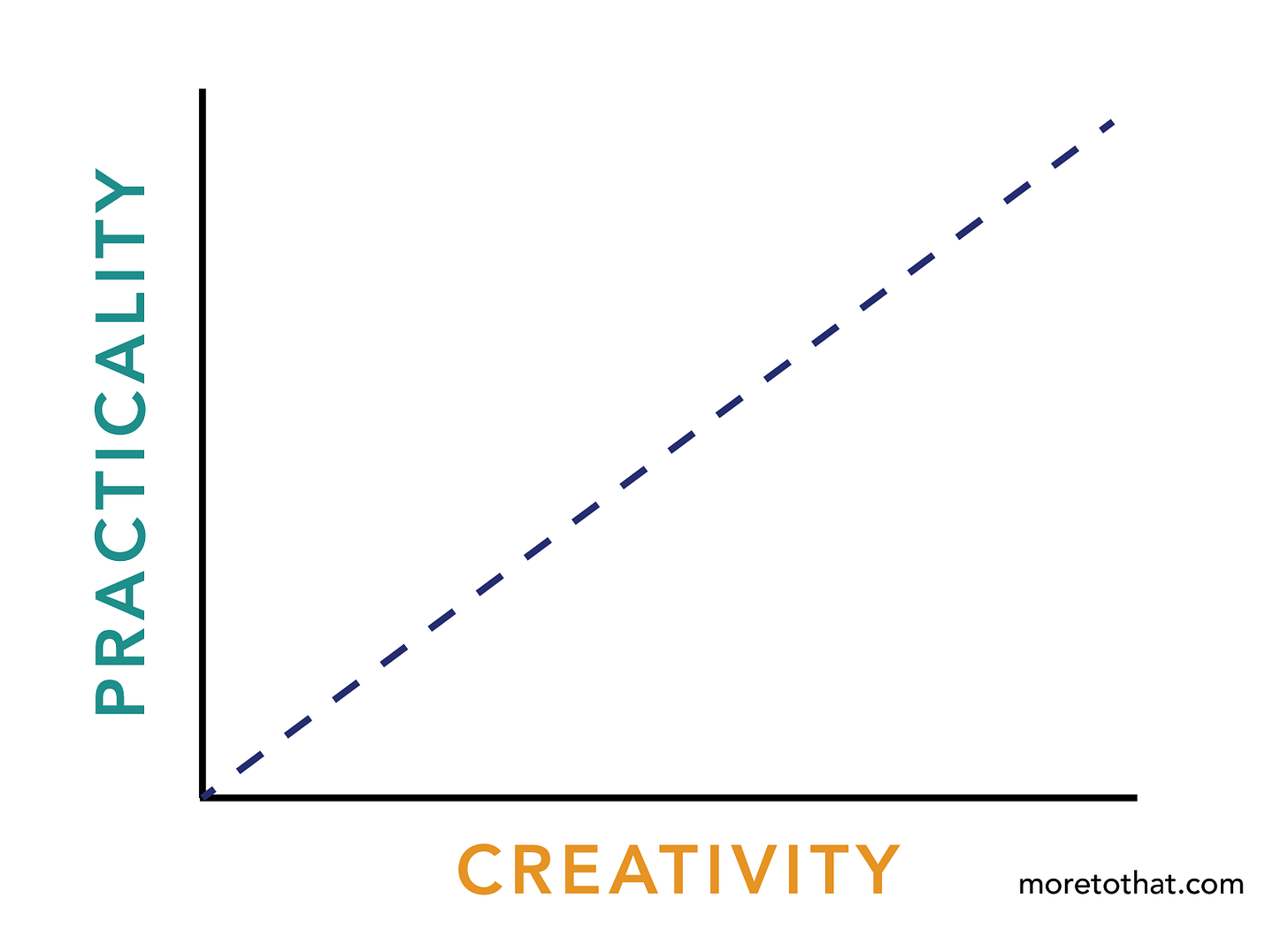Are you being a Practical Creator? In response to the viral essay by Lawrence Yeo
Coaching people in entrepreneurial careers gives me a perspective on the essay 'The Arc of The Practical Creator' to share with you today.
In two years writing this newsletter, I have waxed lyrical on the powers of time and money (or lack of) in influencing your entrepreneurial abilities.
So I was a little excited to see this very topic garner much attention when Lawrence Yeo, creator of More To That published ‘The Arc of the Practical Creator in May’ and I have seen it quoted and shared on the interwebs ever since.
At the time I was knee-deep running The Ask’s inaugural Talent to Money summit and only now am I getting around to writing the response I’ve been wanting to. A response not out of disagreement (this essay is seminal and deserves to stand the test of time) but because I have some things to say.
I am a coach for entrepreneurial career paths. Therefore, knowing the differences between these types of paths is important to me, if perhaps even a mild obsession. This gives me a nuanced perspective and I feel his essay leaves out an important dimension.
Specifically — the distinction between being a ‘creator’ and being a ‘founder’ or another type of business owner. Sometimes I think “It’s just semantics, get over it!” but then I really do believe it matters because it comes down to how you divert your attention and ultimately get paid — which I will refer to as ‘the business model of creatorship’.
Yes, like entrepreneurship.
I hope this post helps you to find more direction in your entrepreneurial path. Whichever label you choose.
New here? I help people seeking clarity in their entrepreneurial career path.
So this essay by Lawrence. If you haven’t read it please do, it’s linked at the bottom of this newsletter (it’s 32 mins long and I need your attention first!). Also, all illustrations below belong to Lawrence. They bring this topic to life much better than my own words could hope to so I’ve included them.
My Notes and Quotes from ‘The Arc of the Practical Creator’
‘The Arc of the Practical Creator’ begins by painting the dichotomy between creativity and practicality.
By this definition ‘practicality’ is referring to how easily wealth is created.
“Creative expression is often used as a gateway to something more practical, and is rarely accepted as something practical in itself.”
For stereotype’s sakes, historically this meant that professions like artists and musicians (most creative/ least practical) would sit on opposite sides to doctors and lawyers (least creative/ most practical).
That is, until the internet changed the game.
Lawrence observes how in recent years, the internet has afforded creators direct access to the people who can pay them for their creative work in a way previously impossible.
Leonardo Da Vinci, Michelangelo and famous creatives of the past had to rely on gatekeepers to act as patrons of their work (ie fund them up front to focus on their art and have their basic needs taken care of).
But in today’s age having access to fans online allows creators to design their own fate and receive compensation for their efforts. So much so, that he believes this reverses the trend and creativity can be much more practical as a profession.
So this is good news! The internet provides us access to people all over the world and thus, wealth can ensue.
Except...
In the early days, when you start out, no one knows who you are and the money doesn’t come.
The trade-off for living a life in pursuit of creativity is the loss of certainty. No one actually cares what you are doing, really. When you first start your ‘creator’ journey since you won’t get approval from society nor hoards of fans you must persevere through this period of anonymity with patience.
Lawrence doesn’t give a time frame for this (in my experience is it will entirely depend on your prior reputation combined with the applied effort, talent and hours logged).
He says that in the early days whilst receiving little-to-no financial rewards, creators must be ‘practical’ in other ways. They must get a job to fund themselves creatively. This is Stage 1: Prioritize Money.
“You exchange your time for money, which is then used to purchase the clarity of attention you can invest into your creative work.”
What Lawrence means here is that your creative work requires your attention. This attention can be much more creative if it’s not also trying to make ends meet and doesn’t have to worry about where the money is coming from in these creative explorations. Much like Michaelangelo.
So after a period of time doing this, and saving up, new creators must choose a moment in time to stop building a financial buffer and go full time on their creative ventures.
When?
When they have saved enough or have seen sufficient signs of progress to feel secure in knowing that enough fans will come and save them with their money!
If and when creators get to this point it is not plain sailing from here. Oh no. Rather, there will be feelings of conviction and relief of having gone full-time, mixed with the tension and doubt they have made the right decision since there are still societal expectations against choosing this sort of path.
On top of that the progress and confidence levels can quickly plateau. Meet Stage 2: The Great Plateau:
“It’s the flat place in the arc where you’re actualizing your creative potential, but are not seeing the practical results of that effort. The customers aren’t pouring in, the audience isn’t growing, people don’t seem to care. The energy invested doesn’t align with expected outcomes, and this situation is rightfully concerning.”
The only way out of this dip is progress — seeing the fans roll in and pay your way out of the dip. Progress is slow though and some creators might have to support themselves with more practical pursuits that get them through this period.
Examples of progress to your own craft might be seeing an improvement in your work, or external validation and less ‘silence’ e.g:
“Perhaps you sent your stuff to a creator you respect, and she encouraged you to keep going. Or you notice that a small but loyal following is developing with every piece you publish. This is a different kind of silence. It’s silence in the sense that your efforts still don’t align with the results, but it’s a signal that you’re headed in the right direction.”
Lawrence writes how persistence here for long enough will eventually get you into Stage 3: The Creative Career.
We traditionally associate the word ‘career’ with traditional forms of employment, but Lawrence explains how once your ‘craft’ has met your practical needs, by definition, it has become your career path.
This is an empowering moment, and he shares anecdotally from his own life this incredible moment in time. It is a choice to double down on the commitment.
“this leap in commitment that occurs when you refer to a hobby as your career is the same as when a love interest becomes your life partner”
Celebration time! The hard work paid off and you have made practicality and creativity align and create not only wealth but fulfilment — what more could you want?
Lawrence then writes about the challenges inherent in Stage 3 around balancing ongoing learning and curiosity (avoiding arrogance) and reinvesting your financial earnings back into your pursuits so that you continue developing your craft.
It is a great read and I hope my summary has done it some justice.
Now for my own two cents.
Nuances to being a ‘practical creator’
What is missing from Lawrence’s essay in my opinion are definitions.
In today’s lexicon being a ‘creator’ typically means pursuing a creative field but using the power of the internet to support you financially. For example a blogger, YouTuber, or podcaster.
Typically these people will flex their creative skills on online platforms and receive payment for their talents in the form of fans, sponsors, affiliates and so on. They are entertaining audiences in some way through their ‘art’ and being paid in return.
So it somewhat alarmed me that an example Lawrence gave was of Brian Chesky, the CEO of Airbnb. Whilst it was to tell the story of Brian calling himself an ‘entrepreneur’ rather than being ‘unemployed’ in his early days (and I’m sure he doesn’t think of Brian as a pure ‘creator’) I wanted to point out that entrepreneurs should be wary of calling themselves creators.
I wrote about this earlier this year.
Why do I care?
Because the monetisation methods are so different for each and time and attention are the most valuable resource you have in your early days of doing your own thing. Direct them accordingly.
Know whether you are trying to become a creator or trying to become an entrepreneur who develops a product or service.
In my interview with John Bardos from Idea Economy about the creator economy, he said that being a creator involves playing the ‘creator game’ which has a specific set of rules. These are:
Creating something
Promoting your work to get an audience
Connecting and networking to develop opportunities
Learning and levelling up your skills
Lawrence’s essay makes an implicit assumption that the creator makes their practical ends meet through an audience who will ultimately bring money as a result.
But it leaves out any details about how this money comes about.
You can in theory build loyal fans and later figure out how to make money from them (and many do). But in my experience, new business owners/creators will have a better experience if they know exactly where this money is going to come from.
Choose your path:

If the ‘creators’ in the stages of the arc that Lawrence is referring to decided to make high-ticket services they would be able to quit their jobs earlier ahead of relying on a large audience because these could cover their bills.
On your creator journey if you plan your ‘business model of creatorship’ early on you can shortcut your path to profitability and ergo, practicality.
Being a more practical creator.
I work with a dozen or so new business owners whose income will likely be tied to the size of their online audience. But are they creators?
Here are some current client examples (names changed):
Alex is building a content platform/newsletter for people in codependent. This newsletter alone even if monetised is unlikely to cover the bills anytime soon. Instead, we are working on a plan for the other products and services to offer alongside the newsletter — and thus prime newsletter readers to buy offers are coming
Jane built a loyal following on Instagram into the tens of thousands. Did the reels thing etc. Then because the creator-audience relationship wasn’t set up to sell services when launching she failed to make sales. She’s now starting a new account from scratch
Amy began with a physical product she created and then built her online audience on TikTok — selling out her first batch because she was able to talk about the product all the time and it was not a surprise but instead aligned to the goals of the TikTok account
Sam has a newsletter and active social accounts and a full-time job she’d love to quit. Our work has been about designing the services she will offer her newsletter readers that will be able to meet her revenue goals — she will test these multiple times before quitting her job.
The only client I work with who is a pure creator by definition of selling their audience to other buyers, wants desperately to build something of their own, so that their income is less dependent on brand deals.
The point I am making here is that having clarity about what you are building is more important than just patience and feeling ‘ready’ because lots of people know about you.
You gotta prime your audience for what you are going to sell them.
It is all very well to work through the first two stages and be patient — but have a plan because likes and fans do not automatically equal revenue.
I’ve written this newsletter consistently for two years and spent over 1,000 hours on it but still doesn’t make me a penny. It costs me. But I have stuck with it because I am not a creator — I am an entrepreneur whose income comes from service including coaching and workshops. If I decided to monetise the newsletter (which is what Substack wants me to do) that would change the ‘business model of creatorship’' for me.
It is appealing. I would get more of that creative freedom Lawrence describes… no longer would the newsletter only need to drive interest for my coaching services but could take on a life of its own and meet my practical needs.
But I would be trading something else; my attention. My attention would then go into writing perhaps at the expense of coaching. The only way to avoid this is to split my time and take on less coaching work to give the writing more focus. That would involved moving into Stage 2 and seeing a drop in income and certainty as a result.
What’s the right choice?
So are you a creator or a founder?
As you can see these lines are blurred so I totally understand why Lawrence didn’t go to the painstaking efforts I have here to bother explaining (!) but my job is to help you figure out the direction you are heading in your entrepreneurial career.
Come spend an hour with me figuring it out and making a plan.
Define your business model of entrepreneurship v creatorship
Understand the rules of the game you are playing and how to measure progress
Generate new ideas for making money from your talents
Learn how to survive the silence and get strategies for navigating the dip when it feels like you’re shouting into the abyss
Feel confident you are on the right path that makes sense for your unique passions, goals, strengths and talents
Join me and a group of like-minded people pursuing entrepreneurial careers and figuring it all out, at Creator or Founder? A Masterclass on Thursday 15th September 1.30pm UK time.
You’ll leave with clarity, a plan and new ideas as well as an editable workbook to complete in your own time. Session recorded if you can’t join live. Get 25% off with the code August25 on tickets purchased before 15th August.
Final shout out to Lawrence Yeo
Everyone — go read The Arc of the Practical Creator essay or pay patronage to his creative work by purchasing a $3 offline copy of the essay here.
More incredible resources from More to That (Lawrence’s creative career) include his newsletter, a course on telling stories, and why the answer to life's greatest question isn't quite what we want to hear.
Thank you Lawrence for your work and inspiring this post.
Thank you as always for reading!
Ellen Donnelly, Founder + Chief Coach, The Ask.









